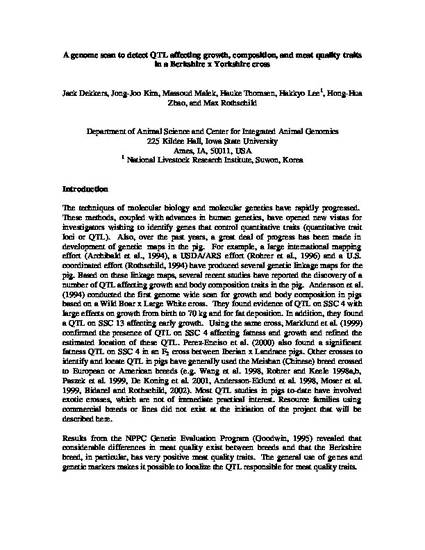
The techniques of molecular biology and molecular genetics have rapidly progressed. These methods, coupled with advances in human genetics, have opened new vistas for investigators wishing to identify genes that control quantitative traits (quantitative trait loci or QTL). Also, over the past years, a great deal of progress has been made in development of genetic maps in the pig. For example, a large international mapping effort (Archibald et al., 1994), a USDA/ARS effort (Rohrer et al., 1996) and a U.S. coordinated effort (Rothschild, 1994) have produced several genetic linkage maps for the pig. Based on these linkage maps, several recent studies have reported the discovery of a number of QTL affecting growth and body composition traits in the pig. Andersson et al. (1994) conducted the first genome wide scan for growth and body composition in pigs based on a Wild Boar x Large White cross. They found evidence of QTL on SSC 4 with large effects on growth from birth to 70 kg and for fat deposition. In addition, they found a QTL on SSC 13 affecting early growth. Using the same cross, Marklund et al. (1999) confirmed the presence of QTL on SSC 4 affecting fatness and growth and refined the estimated location of these QTL. Perez-Enciso et al. (2000) also found a significant fatness QTL on SSC 4 in an F2 cross between Iberian x Landrace pigs. Other crosses to identify and locate QTL in pigs have generally used the Meishan (Chinese) breed crossed to European or American breeds (e.g. Wang et al. 1998, Rohrer and Keele 1998a,b, Paszek et al. 1999, De Koning et al. 2001, Andersson-Eklund et al. 1998, Moser et al. 1999, Bidanel and Rothschild, 2002). Most QTL studies in pigs to-date have involved exotic crosses, which are not of immediate practical interest. Resource families using commercial breeds or lines did not exist at the initiation of the project that will be described here.
Available at: http://works.bepress.com/max-rothschild/181/

This proceeding is published as Dekkers, J., J.-J. Kim, M. Malek, H. Thomsen, H. Lee, H.-H. Zhao, and M. F. Rothschild. 2003. A genome scan to detect QTL affecting growth, composition, and meat quality trait in a Berkshire x Yorkshire cross. Proc. 28th National Swine Improvement Federation Meeting, Des Moines, IA, Dec. 4-5. Posted with permission.